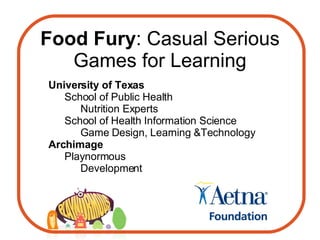Games For Health 2008 Food Fury
- 1. Food Fury : Casual Serious Games for Learning University of Texas School of Public Health Nutrition Experts School of Health Information Science Game Design, Learning &Technology Archimage Playnormous Development
- 2. Problem: Childhood Obesity Recent research has shown that the obesity rates among children are increasing. This increase is alarming, as obesity is associated with chronic diseases such as cardiovascular disease and diabetes. It is thought that the lack of physical activity and the consumption of high energy foods contribute significantly to the problem
- 3. Solution: A Fun Way to Learn Create an electronic environment as an intervention for healthy behavior change. Use games as a way to engage kids in learning about nutrition and physical activity. Food Fury is a game to be used within a suite of casual games in an electronic environment as part of an after school program that includes exercise.
- 4. ╠²
- 6. Food Fury Game Board color coded food tiles food descriptions timed gameplay time bonuses tile mixup function
- 7. Game Mechanic Select food tiles in like-groups of Go, Slow, or Whoa. To remove tiles from the board and get points, double click or press the enter button on the right of the game board.
- 8. Pilot Testing Methods Convenience sample of 32, 3rd to 6th graders in an after school program, in Houston, TX and Bend, OR. Inclusion criteria: children must be engaged in gameplay and get to at least level 3. One sample, pretest-post test design
- 9. Demographics Average Age: 10 years old Age range 8-12 years, Grade range 3-6th Majority of the children in 4th grade (n=14) 16 girls and 16 boys 46% Hispanic 28% Caucasian 21% African American 4% Asian
- 10. Computer Literacy How often do you use the internet? 3.6 1 everyday - to - 5 once a month Rate yourself - internet, Average 3.4 1 much worse - to - 5 much better Rate yourself - computer, Average 2.9 1 much worse - to - 5 much better 25 of the 32 children had a computer at home
- 11. Testing Tool Children categorized 44 food icons as either Go, Slow, or Whoa. 40 of the icons where foods that were represented in the game and 6 were novel. Children filled out the pretest 0-3 days before their exposure to the game. All children played at least until they got up to level 3. Go Slow Whoa circle one answer
- 12. Knowledge Results Items seen in game 21.2 to 24.6, Delta of 3.4 items On average, kids could recognize 3.4 more food items correctly on the post test Eliminating high knowledge items 13.7 to 19.2, Delta of 5.5 items If you eliminate the items that got high scores on both the pretest and the post-test the positive learning change was even greater
- 13. Change by Grade Education Delta 3rd graders - 0 4th graders - 3.5 5th graders - 5 6th graders - 5.2
- 14. Time on Task Three children returned and voluntarily continued to play the game for 30-40 minutes. (50-70min) For these children with the additional exposure, the average pretests were 31.7 (72%) and the average second posttest scores were 40 (90.9%). The longer the engaged exposure to the game, the closer to 100% correct identification.
- 15. Other results Children where asked if they would play the game outside of school and all answered yes. From a set of words that ranged from fun and exciting to boring, children chose: Positive words: fun, cool, great, awesome,wow, nice Negative words: confusing Indicates an overall very high satisfaction
- 16. Usability Scale: 1- no, 2- kind of, 3- yes easy to use - 2.7 understand levels - 2.9 understand directions - 2.6 understand game scoring - 2.6
- 17. Some Quotes ŌĆ£ it was fun because you got to have fun while learningŌĆØ ŌĆ£ The noises were kind of annoying. And the thing that made it fun was all the pressure.ŌĆØ ŌĆ£ It was annoying cause it's it's kind of hard but fun cause it was learning.ŌĆØ ŌĆ£ It was very awesome, it's awesome, the challenge.ŌĆØ
- 18. Conclusion shows preliminary learning overall satisfaction points to ways we can improve instructions to bring the children at a lower developmental level up to speed so they can play and learn
- 19. Yeah Right! How do you think this game is actually going to prevent or treat obesity?? no, not really, its just a part of our plan to build a virtual world to support health behavior change
- 20. ╠²
- 21. Monster Minis
- 22. ╠²
- 25. Monster worlds.
- 26. Monster worlds.
- 27. Cynthia Phelps University of Texas Health Science Center at Houston School of Health Information Science [email_address]



























![Cynthia Phelps University of Texas Health Science Center at Houston School of Health Information Science [email_address]](https://image.slidesharecdn.com/games-for-health-2008-foodfury-1210630628385097-9/85/Games-For-Health-2008-Food-Fury-27-320.jpg)